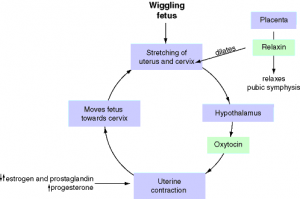IV. PREGNANCY & DEVELOPMENT
A. Fertilization
1. Oviduct is site
2. Capacitation
Enables sperm to fertilize ovum
3. Diploid; Zygote
4. Sex determination
5. Twins
a. Dizygotic (fraternal)
b. Monozygotic (identical)
B. Cleavage (30hrs.-4days); Morula
Mitosis divisions as embryo travels along oviduct towards uterus
C. Blastocyst Stage (day 5)
Rearrangement of cells, embryo is in the uterus
1. Trophoblast cells
Outermost cells destined to become placenta
2. Inner cell mass
Group of cells destined to become fetus
3. Implantation (Day 7-8)
Embryo burrows into endometrium
D. Gastrulation & Germ Layers (2nd week)
1. Ectoderm
Outer germ layer destined to become nervous tissue and skin
2. Mesoderm
Middle layer destined to become skeleton, muscles, heart, vessels….
3. Endoderm
Inner layer destined to become lungs and GI organs
E. Neurulation (3rd week; embryo is 2 mm long)
1. Neural grove
2. Neural tube
Results in brain and spinal cord
F. Organogenesis (4th week; 5mm long)
1. All major organs, arm/leg buds, have begun their formation
2. Thalidomide ; German measles can adversely affect organogenesis
G. Embryo vs Fetus– by end of 3rd mo., all major organs
established [25 mm, 1 gram], all left is growth for 2nd & 3rd trimester
H. Maintenance of endometrium
1. Estrogen & Progesterone
Quite important in maintaining endometrium, from corpus luteum in early pregnancy, from placenta later in pregnancy
2. Birth control pills
Most are a combination of estrogen and progesterone, what does this do to ovulation?
3. HCG (2-12 wks)
Human Chorionic Gondotropin, made by embryo, maintains corpus luteum
I. Placental development (begins at 4 wks, mostly functional by 12 wks)
1. Overall function
Nutrients, Waste, Estrogen & Progesterone production
2. Maternal tissue
– Decidua basalis
Of endometrium
3. Fetal tissue
a. Trophoblast cells become the…
b. Chorion
c. Villi
d. Umbilical Artery & Vein form capillary beds in villi, which become surrounded by maternal blood
e. Umbilicus
Arteries and vein
f. Amnion, Amniotic fluid
Sac surrounding fetus, filled with fluid for protection, movement, and temperature constancy
J. Gestation (280 days)
K. Parturition
1. Labor (contractions every 30 min)
2. Amniotic fluid released
3. Positive feedback
As labor increases, Oxytocin increases
a. Increased estrogen which increases
uterine contractility towards end of pregnancy, then levels drop
b. Decreased progesterone
c. Prostaglandin
Made by placenta, causes uterine smooth muscle contraction
d. Oxytocin (Increased # receptors)
Causes strong uterine contractions
e. Head as a wedge
f. Relaxin, made by placenta
helps to dilate cervix, relax symphysis pubis
4. Afterbirth [10-45 min later]
Placenta

